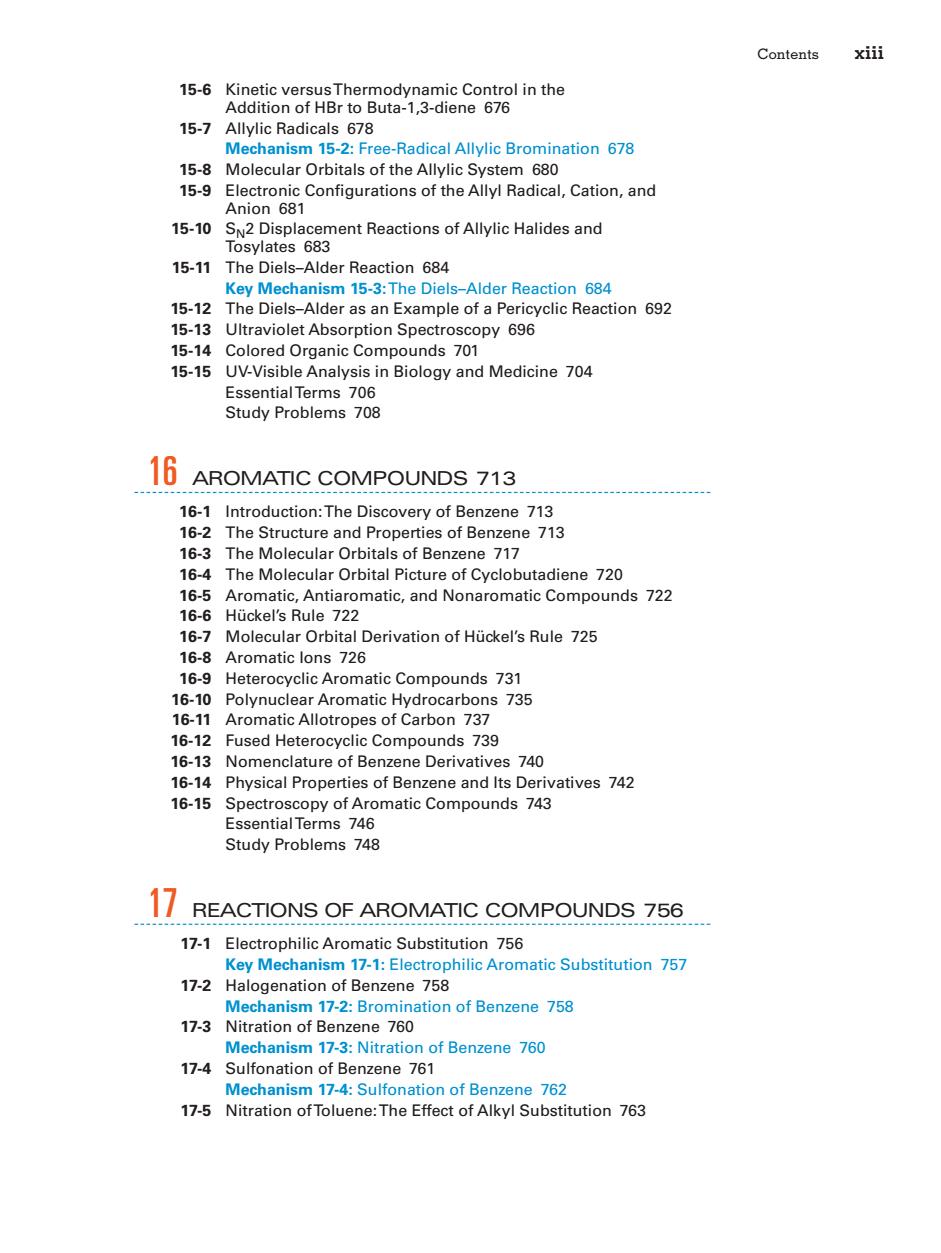正在加载图片...

Contents xiii 15-6 15-7 Allylic Radicals 678 Mechanism 15-2:Free-Radical allylic Bromination 678 15-8 Molecular Orbitals of the Allylic System 680 15-9 Electronic Configurations of the Allyl Radical,Cation,and Anion 681 15-10 15-11 The Diels-Alder Reaction 684 Key Mechani sm 15-3:The Diels-Alder Reaction 684 15.12 The diels-Alder as an example of a pericyclic reaction 692 15-13 Ultraviolet Absorption Spectroscopy 696 15.14 Colored Organic Compounds 701 15-15 UV-Visible Analysis in Biology and Medicine 704 EssentialTerms 706 Study Problems 708 16 AROMATIC COMPOUNDS 713 16-1 Introduction:The Discovery of Benzene 713 16-2 The Structure and Properties of Benzene 713 16-3 The Molecular Orbitals of Benzene 717 16-4 The Molecular Orbital Picture of Cyclobutadiene 720 16-5 Aromatic,Antiaromatic,and Nonaromatic Compounds 722 16-6 Huckel's Rule 722 16-7 Molecular Orbital Derivation of Huckel's Rule 725 16-8 Aromatic lons 726 16-9 Heterocyclic Aromatic Compounds 731 16-10 Polynuclear Aromatic Hydrocarbo s735 16-11 Aromatic Allotropes of Carbon 737 16-1 Fused Heterocyclic Compounds 739 16-13 Nom nclature ot Benz ne Derivatives 740 1818 Physical Prope s of Be zene and Its De tial topy of A Stu d 17 REACTIONS OF AROMATIC COMPOUNDS 756 17-1 Electrophilic Aromatic Substitution 756 Key Mechanism 17-1:Electrophilic Aromatic Substitution 757 17-2 Halogenation of Benzene 758 Mechanism 17-2:Bromination of Benzene 758 17-3 anism 173: ene 760 Nitrati of Benzene 760 17-4 Sulf nzene 76 anism 4: n of B 764 17-5 Nitration of luene:The Ef ubstitution 763Contents xiii 15-6 Kinetic versus Thermodynamic Control in the Addition of HBr to Buta-1,3-diene 676 15-7 Allylic Radicals 678 Mechanism 15-2: Free-Radical Allylic Bromination 678 15-8 Molecular Orbitals of the Allylic System 680 15-9 Electronic Configurations of the Allyl Radical, Cation, and Anion 681 15-10 SN2 Displacement Reactions of Allylic Halides and Tosylates 683 15-11 The Diels–Alder Reaction 684 Key Mechanism 15-3:The Diels–Alder Reaction 684 15-12 The Diels–Alder as an Example of a Pericyclic Reaction 692 15-13 Ultraviolet Absorption Spectroscopy 696 15-14 Colored Organic Compounds 701 15-15 UV-Visible Analysis in Biology and Medicine 704 Essential Terms 706 Study Problems 708 16 AROMATIC COMPOUNDS 713 16-1 Introduction: The Discovery of Benzene 713 16-2 The Structure and Properties of Benzene 713 16-3 The Molecular Orbitals of Benzene 717 16-4 The Molecular Orbital Picture of Cyclobutadiene 720 16-5 Aromatic, Antiaromatic, and Nonaromatic Compounds 722 16-6 Hückel’s Rule 722 16-7 Molecular Orbital Derivation of Hückel’s Rule 725 16-8 Aromatic Ions 726 16-9 Heterocyclic Aromatic Compounds 731 16-10 Polynuclear Aromatic Hydrocarbons 735 16-11 Aromatic Allotropes of Carbon 737 16-12 Fused Heterocyclic Compounds 739 16-13 Nomenclature of Benzene Derivatives 740 16-14 Physical Properties of Benzene and Its Derivatives 742 16-15 Spectroscopy of Aromatic Compounds 743 Essential Terms 746 Study Problems 748 17 REACTIONS OF AROMATIC COMPOUNDS 756 17-1 Electrophilic Aromatic Substitution 756 Key Mechanism 17-1: Electrophilic Aromatic Substitution 757 17-2 Halogenation of Benzene 758 Mechanism 17-2: Bromination of Benzene 758 17-3 Nitration of Benzene 760 Mechanism 17-3: Nitration of Benzene 760 17-4 Sulfonation of Benzene 761 Mechanism 17-4: Sulfonation of Benzene 762 17-5 Nitration of Toluene: The Effect of Alkyl Substitution 763